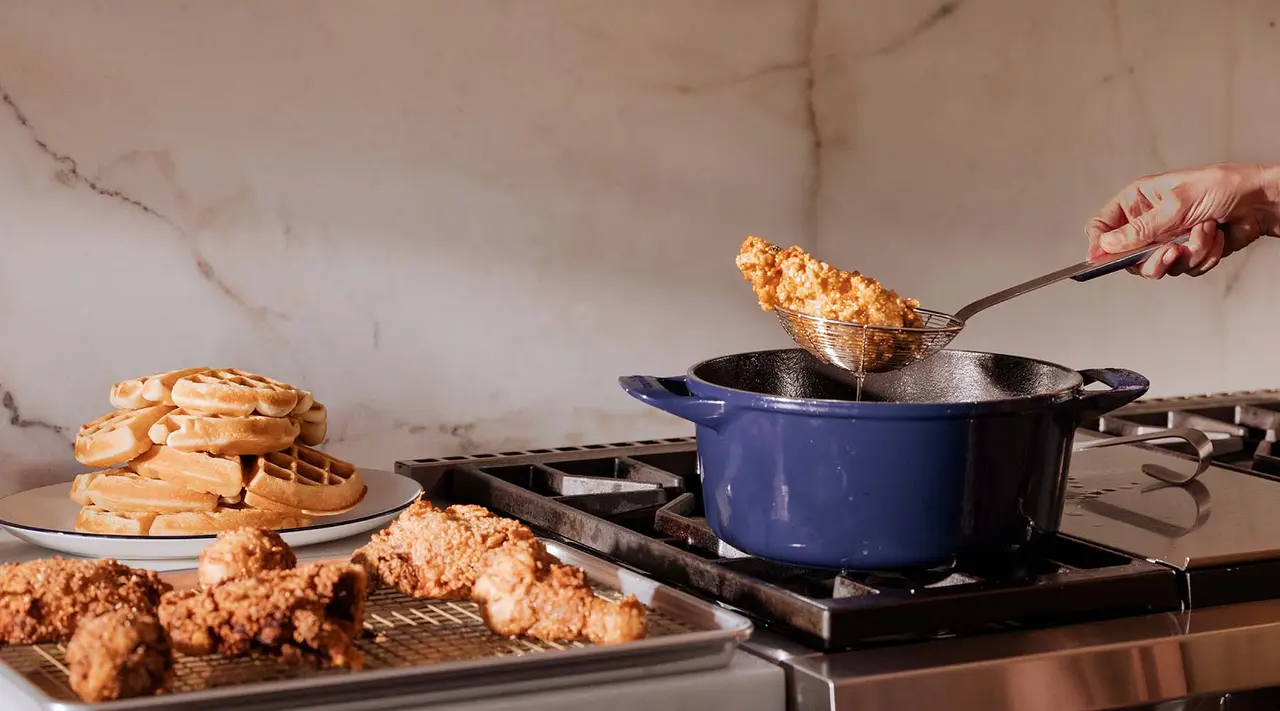Dutch Ovens are useful for a wide variety of different kitchen tasks, and deep-frying is no exception. While our Enameled Cast Iron Dutch Oven may seem too delicate for scorching-hot deep fry oil, it’s actually an ideal tool for the job. One of the main reasons you should consider a Dutch Oven for making treats like donuts or fried chicken is that the cast iron core helps bring oil up to the high temperature required for deep frying, which is typically around 350F. It also helps to maintain that temperature, as well as distribute it evenly for perfectly cooked food. Plus, as an added bonus naturally-nonstick enamel coating also makes for easy cleanup.
Here’s everything you need to know about deep frying in a Dutch Oven and how to do so successfully.
Can You Deep Fry in a Dutch Oven?
It’s a misconception that you need a whole new deep fryer for crispy fried fish and perfect at-home french fries. Unless you’re deep frying multiple times a week, there’s really no need for one in a home kitchen. Space is at a premium for many home cooks and deep fryers take up valuable counter space for their limited uses. Instead, the same pot you use for braising, roasting, or baking bread can easily be used in place of a deep fryer.
Why are Dutch Ovens Good for Deep Frying?
The Dutch Oven’s heavy bottom and thick sides make for excellent heat retention and distribution. This is important, as oil that’s too hot can lead to food that’s burnt on the outside and raw on the inside, while oil that’s too cool can result in food that’s soggy instead of crispy—a major bummer.
Another reason to deep fry in a Dutch Oven is safety. The combination of depth and high sides help prevent splattering—an absolute must in this case, considering you’re working with bubbling-hot oil. That depth also makes this tool better suited for frying large foods like chicken legs than the shallower Wok.
How to Deep Fry in a Dutch Oven

Deep frying in a Dutch Oven is simple. To set yourself up for success, however, you’ll need a few tools and to do a bit of setup before you start. Like stir-frying, deep frying goes quickly, so it’s best to have everything fully prepped so you fry your ingredients off in batches and avoid burning anything. Follow these steps to get started.
Step 1: Gather Your Tools
Before you start heating up your oil, you’ll want to attach a deep fat thermometer to your Dutch Oven to help indicate when the oil is hot enough. It’s also helpful to have a Sheet Pan and Rack or a paper towel-lined plate set aside to help drain away excess oil and keep your food crispy instead of greasy.
Step 2: Heat Your Oil
Pour neutral oil (like vegetable or sunflower) into the Dutch Oven until it reaches about halfway up the sides. It should be deep enough to fully submerge your food, but shouldn’t reach too close to the top of the pot. Too much oil will result in more splatter and increase the chances of getting burned by hot oil.
Step 3: Fry Away
Now comes the fun part. Once your thermometer registers 350-375F, depending on your recipe, use tongs or a spider skimmer to slowly lower your food into the oil. You’ll know your ingredients are fully cooked when they float to the surface of the oil.
Step 4: Drain
Transfer your finished food to your waiting Sheet Pan to drain. Sprinkling with salt or spice blends when your food is fresh out of the fryer helps the seasonings adhere better and also keeps them crisp.
Tips for Deep Fry Success
Before whisking up a batch of batter, check out these last few tips on deep frying in a Dutch Oven to help ensure perfectly brown, crispy food every time.
Use the Right Oil
When it comes to deep frying, not all oils are created equally. The low smoke point of flavorful oils like walnut or sesame means they’ll start to produce unpleasant smoke at high temperatures, and their strong flavor profile might overwhelm the taste of your food. Instead, use neutral oils like vegetable, sunflower, or even refined coconut oil.
Leave Room for Your Food
When deep frying, a key thing to remember is not to dump all of your food in at once. Doing so will quickly lower the temperature of the oil and lead to sad, soggy food. Instead, fry in batches, transferring each batch to your Sheet Pan before adding the next.
Be Patient
While deep frying is one of the quickest cooking methods out there, it still requires a bit of patience. Your food is finished when it floats to the surface of the oil. This could take as little as three minutes for delicate foods like donuts, and as long as 20 minutes for big pieces of fried chicken.
Ready to Cook?
Deep frying is a little more hands-on than methods like roasting or boiling, but with a Dutch Oven, it’s still totally accessible for the home cook. If you don’t have a Dutch Oven yet, this is yet another reason to invest in one. Our Enameled Cast Iron Dutch Oven can be used for almost any other kitchen task, from low and slow braises, to pasta dishes, to deep fried delights. Watch as Pastry Chef Audrey Scheib from the Salty Donut makes Apple Cider Cake Donuts with Chai Glaze. They take some time and planning but are a great weekend project while apple cider is still in season.































